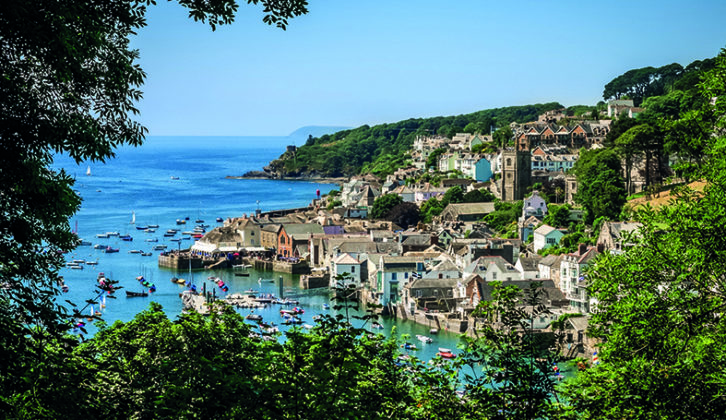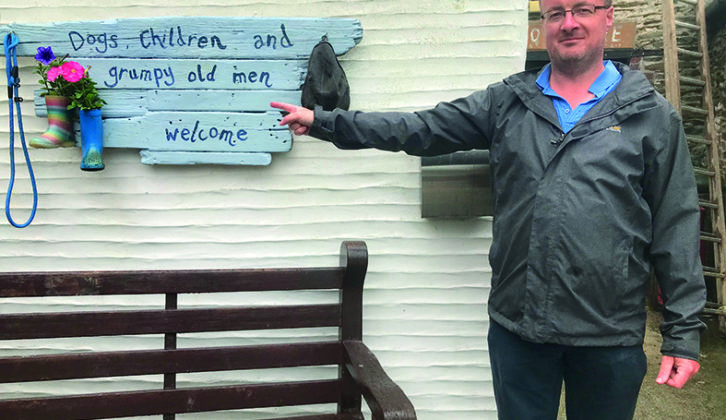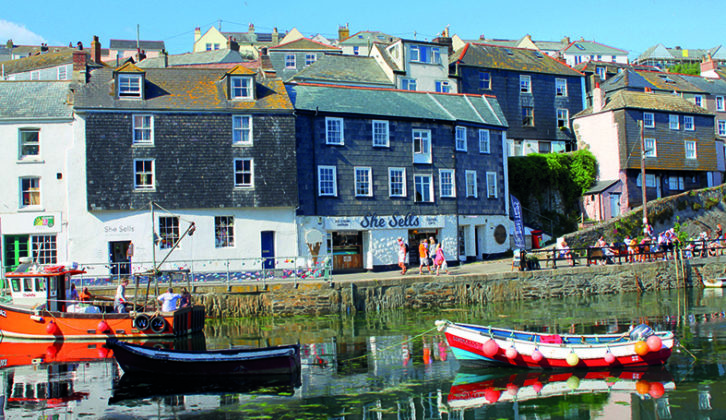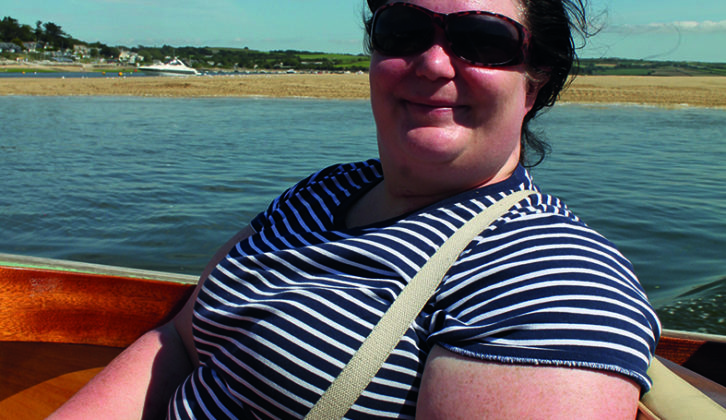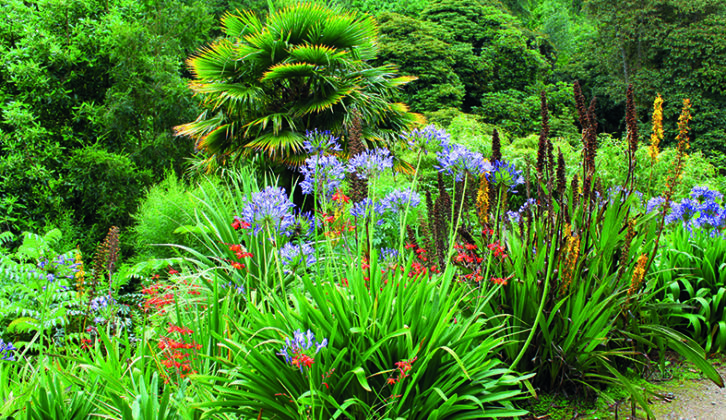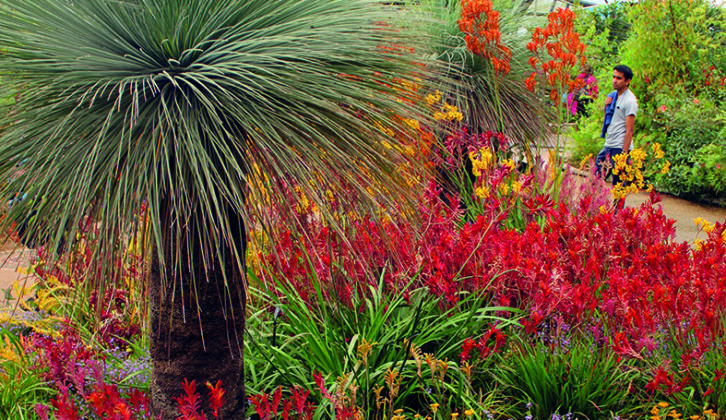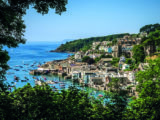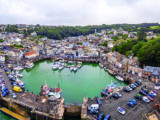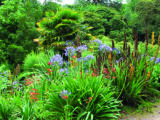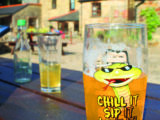The story of this holiday begins at the end of our previous trip. Rose’s cousin Fran, to whom we had paid a flying visit while in Cornwall for the New Year, invited us to return for longer in summer. We were only too happy to oblige and by late February, all of us had got as far as booking time off in late July.
We all know what happened next. A certain pesky virus saw non-essential travel prohibited, brought the hospitality industry to a standstill and meant that a planned weekend away for my birthday in April had to be abandoned.
The lockdown continued into May, and it was looking as though summer holidays might not be a feature of 2020. But in June, things began to improve, until it was finally confirmed that campsites could reopen from 4 July.
We booked two sites, planning a week’s stay at each. A prompt start on Sunday morning saw us arrive at the first, East Crinnis Holiday Park, near St Austell, by early afternoon.
The staff gave us a warm welcome, showed us to a beautiful pitch and advised that the nearest beach, Carlyon Bay, was a 20-minute walk.
With the sun blazing in a manner quite unsuited to a typical British summer, we lost little time in making our way along the cliff path. My swim in the sea was the first of many over the coming two weeks, and the presence of a bar and pizza oven on the beach really was the icing on the cake.
Walking onto a film set
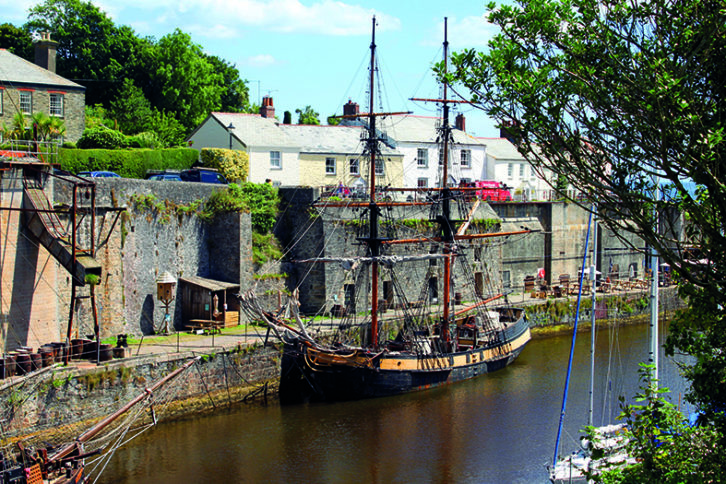
The next morning, we had a look at a map and realised that if we walked past Carlyon Bay and continued on the cliff path for about another 20 minutes, we would arrive at Charlestown.
Built as a Georgian ‘New Town’ at the end of the 18th century for exporting copper and china clay and importing coal, Charlestown is named after its creator, local entrepreneur Charles Rashleigh.
The town remains almost entirely unspoilt by modern development, and is a popular location for films and TV shows, with Poldark, Hornblower and Mansfield Park among its many credits.
The sun was beating down from a clear sky and our walk included inventive moves on Rose’s part to find shade. We didn’t mind, because the views were breathtaking and Charlestown was rather wonderful. With a fleet of square-rigged ships moored in the harbour, it felt as though we were strolling onto a film set.
There’s another reason for it being memorable – it was the location of my first (but by no means last) Cornish pasty of this holiday!

Charlestown hosts the Shipwreck Treasure Museum, in a historic china clay building. We were told this is well worth a visit, but with the temperature rising, we opted for the beach.
Porthpean, a mile along the coast from St Austell, is a wide, sheltered bay, popular for kayaking, windsurfing, rock pooling and swimming. The only disadvantage was its east-facing position, which meant that by the time we arrived in the late afternoon, the beach was largely in shade.
In the morning, though… wow! I got up early next day to go and have a look, and was rewarded by stunning scenes of the sun reflected off the sea, all the way to the horizon. The temptation to swim was irresistible – even though the water proved to be much colder than it looked!
Fowey and Mevagissey
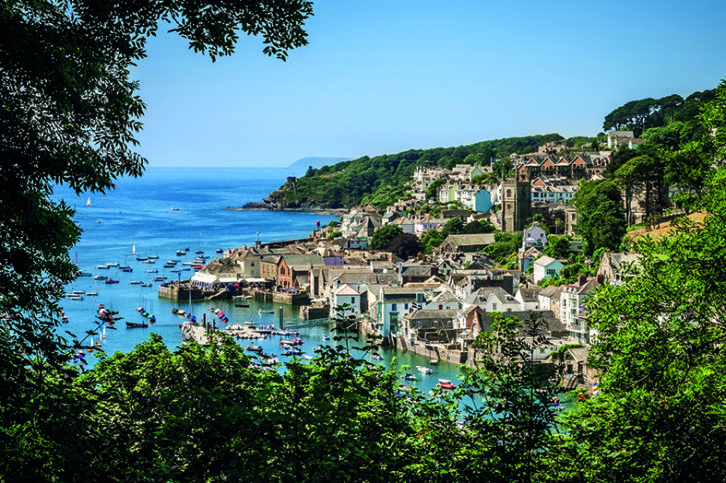
Later – after an excellent bacon sandwich from the campsite café – we drove the six miles to Fowey (pronounced ‘Foy’). Named after the estuary on which it lies, and set in an Area of Outstanding Natural Beauty, this is a charming town, with medieval buildings complemented by more recent Georgian developments.
Fowey’s streets have many independent shops selling clothes, jewellery, art and other such items. Personally, I preferred to experience the view from the water, and there are plenty of boat operators catering for that. We chose a very scenic 45-minute cruise along the estuary, which takes in plenty of interesting sights.
Among them are two 14th-century gatehouses on either side off the harbour mouth. These were once used to suspend chains to close the harbour when needed. Ferryside, meanwhile, on the other side of the river at Bodinnick, was the home of author Daphne du Maurier, where she wrote her first novel, The Living Spirit, in 1931.
Point Neptune House could also be seen on the cruise – it is on the mouth of the Fowey Estuary and was built in 1862 by the Rashleigh family, who were prominent landowners. Until recently, it was the home of Dawn French, whom the boat skipper claimed was often to be spotted walking her dogs here. Then there was the former Lloyds Bank on Fowey Harbour. This luxury holiday home, then owned by TV chef Gordon Ramsey, could be rented – at up to £7000 per week.
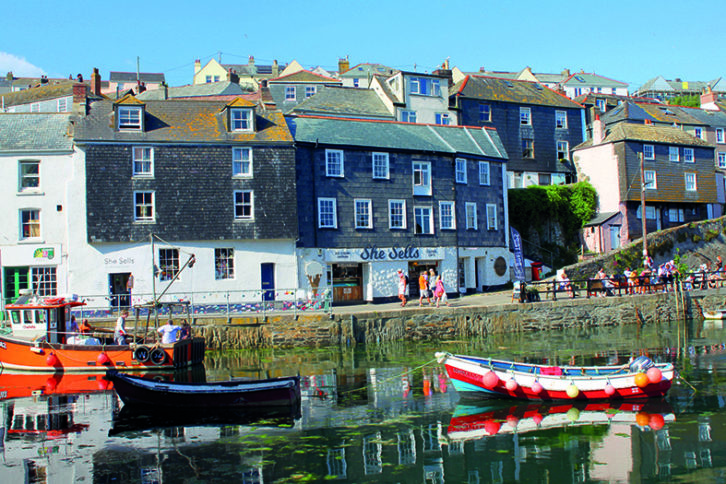
Unfortunately, we were unable to board the ferry to Mevagissey (‘Meva’ to the locals), because social distancing constraints prevented it from operating. We drove there instead, which was the next best thing.
Mevagissey is a charming fishing village that has largely resisted any form of development. The harbour has been updated to accommodate modern fishing boats, but otherwise the narrow streets and alleys feel like they’ve barely changed. We loved it, especially Hurley Books, which sells a good selection of secondhand books, as well as maps, guides and works by local authors.
On your bike
I had decided before coming to Cornwall that one ‘must do’ activity would be to cycle the Camel Trail, which follows the route of an old railway line from the ancient county town of Bodmin to Padstow, on the coast.
However, discovering that there was an official cycle route to Bodmin from St Austell, crossing part of Bodmin Moor, I decided to expand my cycling journey to include this, at a total distance of 26 miles. Rose would drive to Padstow to spend time browsing the local shops and I would get an easy journey home.
I made this plan in blissful ignorance that first, the next day would be the hottest of our holiday, and second, the initial three miles out of St Austell are steeply uphill. By the time I managed to reach level terrain, so much sweat had run into my eyes, it was getting rather tricky to see!
And while I know it’s physically impossible for at least three-quarters of the rest of the way to Bodmin to be uphill, that’s what it felt like. The relief when I reached the Camel Trail, knowing this had to be sensibly flat, was immeasurable.
But the ride was worth it. The first six miles of the Camel Trail, to the pretty market town of Wadebridge, passed mostly through woodland and felt refreshingly cool. Many of the former station platforms remain intact, and there are several tea rooms where you can enjoy a break.

The next part of the route takes your breath away. It follows the Camel Estuary, a deep valley that became submerged by post-glacial rising sea levels. I was fortunate enough to see the estuary at low tide, when mud flats, sandbanks and reed beds are exposed and teem with wading birds. It’s simply sensational.
Padstow is everything you could want a fishing village to be. You can lose yourself watching the ebb and flow of activity in the busy harbour, and when hunger drags you out of your reverie, there is every possible type of eatery, from bakeries, to cafés selling the catch of the day, to Rick Stein’s gourmet seafood restaurant. It’s also surrounded by glorious sandy beaches.

Sadly, we were by no means the only people to have decided to pay a visit that day, and the narrow streets and small shops felt uncomfortably crowded. So, after a much-needed cold drink and a short but exhilarating ride in a speedboat to the head of the Camel Estuary, we drove north to Port Isaac. This village is perhaps best known for its role as Portwenn in TV series Doc Martin. I could recognise some of the street scenes, but couldn’t for the life of me remember which house features as the doctor’s surgery. Of course, it turned out not to be one that I photographed!
I ended the day with another swim, this time off the beautiful sandy beach at Mawgan Porth, at sunset. It’s almost impossible to put into words how great that was, but ‘perfect’ will do for now.
Looe and Polperro
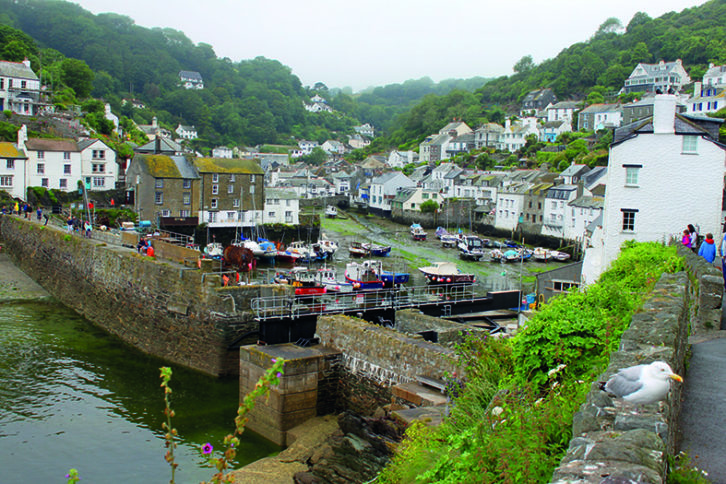
Sadly, ‘perfect’ isn’t a word we felt able to use to describe Looe, where we decided to visit the following day, after waking to see that it had dawned cloudy and overcast.
Yes, its setting on the river is pleasant, and the wide sandy beach would probably have felt more inviting on a brighter day. But the town features mostly chain stores and lacks the unique feel of some of the other places we had visited.
So – after a consolation cream tea – we drove to the neighbouring village of Polperro, and found this to be much more to our taste.
Built in a river valley, the original settlement here is believed to date back to the 12th century. Now, whitewashed cottages cling to the hillsides around the small harbour. Some of the buildings house the obligatory mixture of boutiques and souvenir shops, but it’s easy to imagine the same places in the late 18th century, when they were more likely to have been used to hide smuggled goods, including brandy, tea, gin and tobacco.
Apparently, Polperro’s very isolated location made it particularly difficult for the customs authorities to catch smugglers in possession of their contraband.
The next day began with another early morning swim off the beach at Carlyon Bay – if only I lived closer to the sea, I could get used to this – followed by a visit to the Lost Gardens of Heligan.
These world-famous gardens were once part of a vast estate, built by the Tremayne family in 1603 and operated totally self-sufficiently. At its peak in the late 19th century the estate included farms, woods, quarries and a brewery.
Sadly, World War I put an end to that enterprise. All of the 22 garden staff signed up for battle, and only six of them were to survive. The house itself became a convalescent home, before being rented out to tenants after the war and later sold as flats.
Horticultural heaven

With no labour or money available to maintain the gardens, they fell into complete disrepair and eventually became overgrown and forgotten.
That is until 1990, when a chance meeting between Tremayne family descendant John Willis, businessman Tim Smit and restoration builder John Nelson led to the discovery of the derelict buildings, glasshouses and pathways beneath the dense layers of overgrowth.

The decision was made to restore the lost gardens to the design and condition of their 1890s heyday. Today, vegetables are grown in walled gardens, meat is produced from their own turkeys, Ryeland lambs and Tamworth pigs and – more remarkable still – the gardens include the UK’s only tropical jungle! Growing in a former quarry, a unique microclimate allows the tropical plants to thrive here. If you’re feeling adventurous, it is also possible to cross above the jungle on the UK’s longest Burmese rope bridge.
Gardens of a different kind

We had waited until our final day in St Austell, when the heaviest showers were forecast, to visit the Eden Project. The transformation from a worked-out china clay pit to the largest captive rainforest in the world in a little over three years was simply spectacular.
The abundant rainforest plants are all housed in a huge bubble-shaped biome, which is apparently large enough to fit the Tower of London inside it, twice over. The main goal of this amazing project is to highlight our dependency on plants, and you can see first-hand how the plants provide natural habitats for birds and insects, and can be used to grow bananas and coffee beans, and to produce rubber, sugar and chocolate.
A second, smaller biome houses more than 1000 varieties of plants from the Mediterranean, South Africa, California and Western Australia. The sights and scents are just beautiful.
By its very nature, the experience promotes the need for conservation, and for me this was exemplified out strongly by Topsy the Turtle. On one hand, this is just an unusually shaped receptacle for the disposal of plastic bottles and packaging. On the other, it highlights, simply and poignantly, the problem of plastic in our oceans.
The Eden Project is fascinating, but with our visit over by mid-afternoon, the rain gone and the sun broken through, we were looking for something else to do.

Healeys Cornish Cyder Farm, near Truro, for which admission tickets were still available was the ideal solution. Pandemic restrictions sadly meant they were unable to offer guided tours of the modern cider production warehouse, but it was still possible to take a self-guided tour around the museum, housing cider-making machinery through the ages, and to admire the farm animals.
You can also sample some of the products – nominate someone else to drive and make the most of it! These include not only the excellent Rattler cider, but also spirits from Cornwall’s first distillery in over 300 years, located on the same premises. The single malt was good, but even I balked at paying over £100 a bottle!
The land that time forgot
Our second week had arrived all too quickly, and this meant moving on to another campsite, on the Helford River peninsula. The first thing that greeted us on our arrival at the site was the view of the river in the valley below.
This is quite simply spellbinding, not just because of its beauty – it really is beautiful – but also because there is barely a building in sight. It felt as though we had entered a part of Cornwall that time had forgotten, an illusion which didn’t really go away as we explored the local area.
The villages of Helford, Gweek and Mullion all looked as though they hadn’t changed very much since the days when the pubs were frequented by smugglers plotting their next escapades, only for their dastardly plans to be foiled by the efforts of Enid Blyton’s Famous Five.
And while Lizard Point – the most southerly spot in mainland Britain – is unsurprisingly more developed for tourists, if you visit during a stiff breeze and stand facing the sea, it still feels wild. Time may not have entirely forgotten this lovely part of the world, but there are some things that it remains powerless to change.
Seals of approval

In what was a fortnight of continuous highlights, the next day was among the best, partly because we visited the Cornish Seal Sanctuary. This is a charity whose main mission is to rescue and rehabilitate grey seal pups that become stranded on the local coastline.
Some might be injured or malnourished, while others have become separated from their mother. During the breeding season (September-March), around 70 seals are rescued, treated and released back into the wild. A small number, including the 19-year-old, blind, probably brain-damaged Ray, become permanent residents.
We were lucky enough to visit the enclosure at feeding time, which is a wonderful spectacle. It’s astonishing to see how animals that are really so clumsy on land become so smooth and streamlined when they enter the water. They would probably say the opposite about us humans!
As the work being undertaken at the centre has grown, it’s no longer just seal pups that they treat. Other ‘patients’ now include sea lions, penguins and otters, and they also look after ponies, goats and sheep in their own unique way. Who would have thought that giving the goats a trampoline to play on would be such a success?
However, this day was also special because, after over a week of waiting, we finally got to meet up with cousin Fran and her daughters Alicia (16), Olivia (12) and Uno (10). The reminiscences and chit-chat went on for almost as long as our visits to the animals. During one of these chats, Fran mentioned that her favourite place in Cornwall was St Michael’s Mount. It’s easy to see why.

This small, rocky island, crowned by a medieval castle and a Benedictine abbey, is only accessible by crossing a causeway at low tide. The view from the beach at Marazion – the closest point on the mainland – is absolutely stunning.
We decided that we had to visit but there were a couple of snags. First, the combination of the island being under private ownership and those irksome social distancing restrictions meant that entry was by ticket only. And the earliest day on which tickets would become available was after the end of our holiday.
But with the weather next day possibly the most glorious it had been yet – and that really is saying something – we decided to have a picnic on the beach anyway, in the hope that we might at least be able to wander across the causeway and take a closer look.
But the tide was high when we arrived, and even after our very leisurely lunch, it still hadn’t retreated enough for the causeway to become fully exposed. So, what to do while we waited? Well, finally managing to persuade Rose to join me in a swim was one pleasant distraction. Meanwhile, Olivia had decided that she would use the time to practise doing some handstands. Una promptly followed suit, although her valiant attempts fell a little bit flat (and wet!).
Breakfast, bike, barbecue, beach
Back at the campsite and poring over a map, we discovered that we had somehow managed to miss out the village of Coverack from our tour of the local surroundings a few days earlier.
We redeemed this by visiting this pretty place the following morning for breakfast, bought from Archie’s Loft and eaten outdoors with views of the picturesque harbour. At Rose’s insistence, I must also mention their congress tarts (the south-west’s version of Bakewells), which are – in her words – ‘divine’.
Breakfast was followed by a short (but steep) bike ride around the Helford Peninsula and then a barbecue, which was again hosted by Fran and at which it was wonderful to meet her partner Tamsen, eldest daughter Indie and sister Ayisha, all of whom had been unable to join us before because of their work commitments.
This was in turn followed by a visit to a local beach, where I enjoyed what would be the final sunset swim of our holiday.
Messing about in boats
The next day was the last one of our trip. Where does the time go? We found the perfect way to spend it – accompanied by Fran, Olivia and Una, we decided to hire a self-drive motorboat. No previous experience is required and believe me, if I can drive it, anyone can. We motored up the river exploring coves and inlets.
If our exploration on land earlier in the week had felt like something from Enid Blyton, today’s expedition was more reminiscent of The Wind in the Willows. And Ratty was absolutely right when he said: “there is nothing – absolutely nothing – half as much worth doing as simply messing about in boats”.
Especially if you happen to be on the Helford River at the time. This gorgeous area looks just as unspoilt from the water as it does from the land. Peaceful, beautiful, wonderful.
Home cooking
That evening we enjoyed a special treat when we were invited by Rose’s other cousin, Mark, and his wife, Mel, to their house for a delicious home-cooked meal. I should have taken a photo to mark this occasion, but for some reason, I clean forgot. We still have the memories, though, and they’re wonderful ones to complete our holiday. We returned home feeling happy, relaxed, refreshed, but most of all thankful.
Thankful to lovely Cornwall for being every bit as beautiful as we could have dreamed. Thankful to the weather, for being mostly glorious. And to all of Rose’s extended family for being so warm and welcoming during our stay.
But perhaps most of all, we were unexpectedly grateful to the virus, for remaining reasonably at bay and allowing us to enjoy our summer holiday as we had hoped and intended.
Sometimes, we feel that we have more luck than anyone is really entitled to expect!
TOUR ESSENTIALS
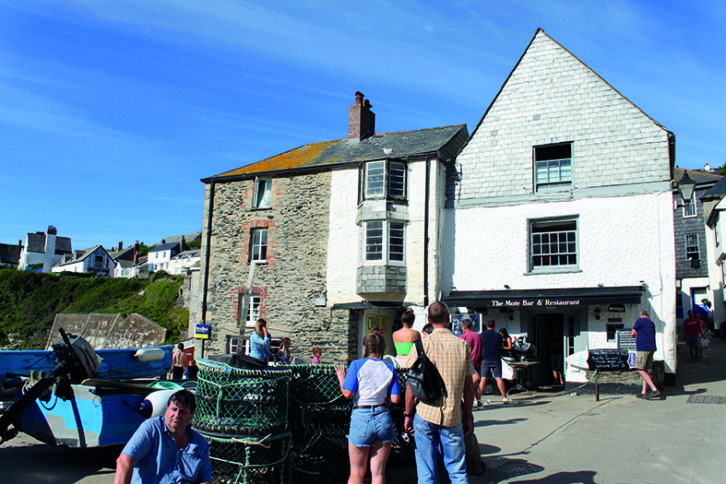
When to go
High season in Cornwall is Easter to October, although many of the larger attractions remain open all year round.
Way to go
Like most people travelling from central England, we followed the M5 and the A30. On Saturdays (the main changeover day for static caravans and holiday homes) this route is best avoided!
Where we stayed
East Crinnis Holiday Park
- Par Moor Road, Par, PL24 2SQ
- Web www.eastcrinnis.com
- Open 12 April – 31 October
- Pitches 25
- Charges £17-£34
An immaculate site that includes two large toilet and shower blocks, a small shop and cafe, and a pond devoted to conservation of local wildlife. Live outdoor music and children’s storytelling are held on some summer evenings. Accommodation in log cabins and yurts is also available.
Helford River C&CC Certificated Site
- Halanoweth, St Martin, TR12 6DE
- Web helfordrivercamping.co.uk
- Open 12 April – 30 September
- Pitches 5
- Charges £13-£16
Access to this CS is not the easiest, and facilities are basic. But it’s peaceful, the pitches are level and the views are simply stunning. The pasties from Gear Farm (just opposite the site entrance) are to die for!
You can also get more great campsite inspiration for the county by taking a look at our guide to the best motorhome sites in Cornwall.
Food and Drink

The range is just about endless, and there is plenty to choose from, apart from the pasties, cream teas and fabulous seafood. This is a small selection of the many great places that we sample during our stay:
- The Old Ship Hotel: Padstow, PL28 8AE
- The Britannia Inn: Par, PL24 2SL
- The Black Swan: Gweek, TR12 6TU
- Gear Farm Pasty Company: St Martin, TR12 6DE
If you liked this… READ THESE:
Cornwall: Practical Motorhome Travel Guide
Bodmin Moor: An Insider’s Knowledge
Best motorhome sat-nav for 2022
If you’ve enjoyed reading this article, why not get the latest news, reviews and features delivered direct to your door or inbox every month. Take advantage of our brilliant Practical Motorhome magazine SUBSCRIBERS’ OFFER and SIGN UP TO OUR NEWSLETTER for regular weekly updates on all things motorhome related.
Padstow is everything you could want a fishing village to be You can lose yourself watching the ebb and flow of activity in the busy harbour
